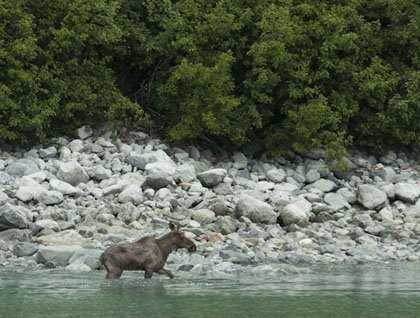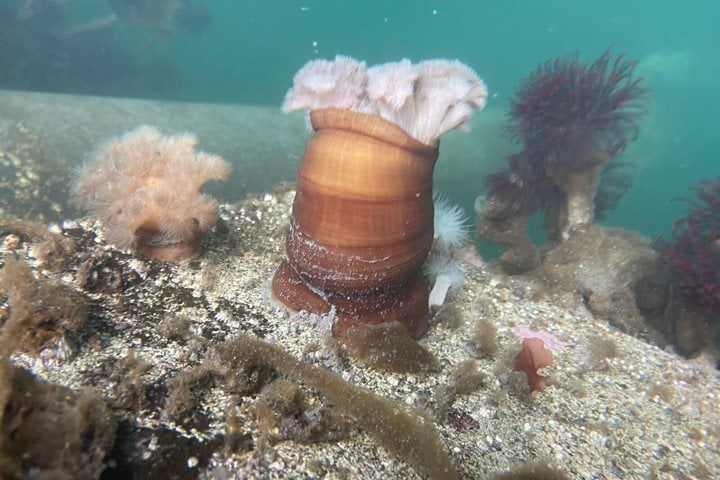Three hundred years ago, Glacier Bay was impossible to see—it was beneath a massive glacier. Today we explored the waters of this recently uncovered land and seascape. Mountains, valleys, and islands scraped clean by glaciers look raw, with bare rock mountainsides and steep rock slopes. But vegetation slowly returns, and after many years, hillsides are green with alders and cottonwoods. After about 200 years, there is a young spruce and hemlock forest. Traveling through Glacier Bay is like traveling through time.
Two people joined us for the day: Linda, a Glacier Bay Park Ranger, and William, a Tlingit cultural interpreter. Tlingit people have lived in and near Glacier Bay for thousands of years.
Shortly after breakfast we cruised very slowly past South Marble Island where hundreds of Steller sea lions were hauled out on rocks. We heard their low roars and grumbles. A couple of humpback whales swam near the island. Kittiwakes and pelagic cormorants perched on steep cliffs. Dozens of tufted puffins sat on the water sporting colorful breeding plumage: long, yellow feathers swept back from their foreheads, and big orange bills.
At Tidal Inlet, we found a brown bear walking on the beach, turning over large rocks with an easy swipe of his paw. He was probably searching for small fishes and crabs. He dragged long claws over boulders, and ate the broken barnacles. The rounded mound of gray limestone called Gloomy Knob was true to its name today; low clouds nearly touched it, and a light mist hung in the air. Several mountain goats were on it, with off-white fur so long it seemed they were wearing puffy pantaloons. We saw a couple of nannies with tiny kids.
In Tarr Inlet, we found a moose! It was a young male with impossibly long legs. He walked down the rocky beach, entered the water and swam 100 yards down the shore. When he exited the water, he ate some willow leaves before lying down in the vegetation.
The Grand Pacific glacier is so black with rocky material on its surface that it barely looks like it is made of ice. Yet this is the glacier that advanced rapidly and forced Tlingit people from their home in the bay. It has since retreated 60 miles, and no longer reaches salt water. Next to it is the beautiful Margerie glacier, the ice clean and white, and even blue in fissures. For ten minutes, we watched and listened in silence. Margerie cracked and groaned. Ice spilled from its face, and minutes later, our ship gently rocked on swells from the calving. While we were quiet, we could hear kittiwakes calling, and a crack from once powerful Grand Pacific glacier.
We turned southwards, and cruised back down the bay. After dinner we docked at Bartlett Cove, where the land is still rebounding after being freed from the incredible weight of the glacier that covered it. We walked on trails through the young forest, while listening to beautiful songs of wrens and thrushes.









